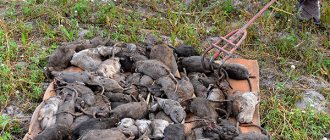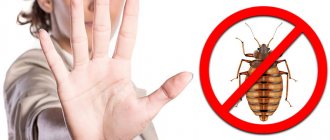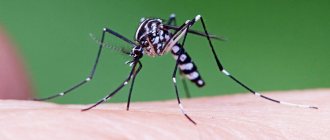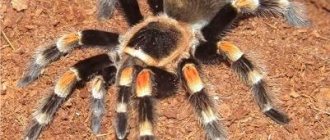Fleas belong to the Siphonaptera family and are parasites that feed on the blood of their host. Insects are ubiquitous. If your pet has fleas, they pose a danger to humans.
Having passed from the larvae to the adult stage, fleas begin to search for a food source. They move mainly by jumping, deftly jumping into the fur of animals. With a body size of 2-4 mm, the flea's jump height reaches 20 cm and length - 40 cm. Among insects, only pennies surpass fleas with record jumps of up to 70 cm in height! This is a hundred times their own height. The body of both types of insects contains resilin, a protein with the ability to accumulate elastic energy, which helps when jumping.
Interesting fact: in proportional terms, for a man 2 meters tall, a flea jump is equivalent to jumping 48 meters in height and 90 meters in length!
Having entered an apartment through pets, the parasites sometimes bother people with their bites. And fears that cat fleas are dangerous to humans are actually not unfounded.
How fleas get on people
Humans are attacked by fleas that live on domestic animals. These insects move very quickly, jumping half a meter, which is a lot for them, because the size of the flea itself does not exceed 3 mm. While scratching or shaking the animal, it can shake off the flea and throw it a very long distance. A flea, in search of food and a secluded place, can jump on a person and bite.
The flea does not always live directly on the victim. They can hide and lay eggs in secluded places. Most often this is a bedding, a doghouse, a house - any place where it is warm, dry, dark. They can also hide in carpets and other textiles with folds or pile. They can get stuck in cracks in the floor, behind baseboards, and in other dark places. Accumulations of garbage also become a haven for them. Fleas can wait in such places for quite a long time. But as soon as a victim appears next to them, they attack. The flea navigates by smell. The smell of animals is much stronger for them and attracts them more than humans. But a hungry flea is not so picky, so it will bite a person too.
Exotic pests
Not only domestic parasites cause trouble: a trip to exotic countries can result in even more exotic problems. So, when visiting India, the Caribbean or Vietnam, you can meet a sand flea, the way of feeding of which is significantly different from the bites almost familiar to humans. This flea bites into the skin and attaches itself directly to a blood vessel. This method of feeding allows the insect to grow several times in size in a few days.
Females carrying eggs feed in this way. The area around the insect becomes inflamed, and the person experiences such pain that he no longer cares whether the fleas carry rabies. Often the discomfort is so severe that the person cannot walk.
Important!
If you develop painful cavities or swellings under your skin while traveling, you should consult a doctor immediately. If the insect is not removed in a timely manner (especially when there are many of them), gangrene is likely to develop. In countries where parasites of this species are typical, a certain number of the local population becomes disabled precisely because of sand fleas and their larvae.
Can fleas live on humans?
They do not live on smooth human skin. It is more difficult to move on it than on wool, and it is impossible to hide in it. Fleas can live in animal fur, but they do not live on humans. True, they can be on clothes and shoes. This is how they travel long distances. For example, a person may bring fleas on clothing from the street or from a flea-infested room.
If a person does not change clothes or wash for a very long time, then fleas can live on him. But we are talking about completely asocial representatives. In other cases, fleas bite a person, but after that they try to hide in other places.
If you do not fight fleas, they multiply very quickly, that is, in the house where the animal lives, there will not be enough food for them, and they will regularly bite the owner. In this case, they will not live on humans.
How to tell if your house is infested with fleas:
- Small bites with drying crusts appear on the body of humans and animals;
- bite sites may become noticeably red if a person is prone to allergies;
- flea bites are located chaotically, and not like when infected with bedbugs that bite “along the path”;
- severe itching;
- Most bites appear on the lower part of the body, especially on the legs, since fleas usually live on the floor, in carpets, in animal bedding and on the animals themselves, and jump on humans from below.
Fleas are not nocturnal like bedbugs. They can bite at any time.
Consequences of flea bites
Perhaps the bites will pass without any consequences. Someone may have a severe allergic reaction and cannot do without anti-allergens. But much more dangerous are infectious pathogens that are carried in flea saliva from infected or dead animals.
Fact! The risk of catching worms during a flea bite is very high. And this does not apply only to humans. All mammals that have been attacked by adult adults can receive helminths “as a gift.”
Do cat and dog fleas bite people and how to get rid of them, read more in the article here.
Is it easy for a person to get fleas?
There is no need to think that fleas appear in people only where there is dirt, garbage and chaos. Of course, without proper sanitation, the risk of flea infestation increases significantly. But fleas can also appear even where hygiene is taken care of. Fleas live wherever there are animals. You can pick them up at the zoo, on a farm, hunting, or while walking in the forest or park. You can bring them from any public place, transport, or work. Even on the playground there can be fleas, because not only children can walk there, but also cats or dogs on their own.
In older homes, fleas can live for decades in basements and attics. There they feed not on the blood of domestic animals, but on rats or mice, which is even more dangerous, since rodents are carriers of the most dangerous diseases, and fleas, by biting them, spread these diseases further. In such houses, residents constantly suffer from infestations of fleas that come from common areas, utility rooms into apartments.
Types of diseases
Due to the fact that fleas are carriers of diseases, parasitologists and doctors classify them as practically the most dangerous ectoparasites. And for good reason, because the consequence of pest bites is a sharp response from the human body, which is expressed very violently during regular attacks by bloodsuckers. When fleas attack a person, they transmit serious diseases, the consequences of which can range from mild irritation to death.
Diseases from fleas When human skin is damaged, fleas carry plague and worms. They can also cause infection:
- anthrax - a disease that results in serious pathologies of the skin;
- tularemia - a disease transmitted to humans from various types of rodents, the disease has a damaging effect on the lymphatic system, accompanied by fever and intoxication of the body;
- typhus – a disease accompanied by severe intoxication of the body and leading to damage to the central nervous system;
- viral encephalitis - a disease that affects the central nervous system and leads to severe clinical symptoms;
- fungal infections;
- salmonellosis - an infection caused by rod-shaped bacteria living in the tissues of birds; the main symptom of the disease is acute intoxication, accompanied by vomiting, diarrhea, and skin rashes;
- trypanosomiasis – a disease caused by sleeping sickness;
- listeriosis - a very common disease caused by rod-shaped bacteria that parasitize the cells of domestic animals and livestock;
- brucellosis is a disease accompanied by severe allergies, sleep disorders, joint inflammation, loss of appetite and general malaise.
Are fleas dangerous for humans?
The flea feeds on blood. To do this, she bites through the skin, injecting a substance into the wound that prevents the blood from quickly clotting. Along with saliva, pathogens that this parasite carries from other animals or people bitten earlier enter the wound. The wound is very itchy. A person scratches it, sometimes very hard, which causes the wound to increase in size and can become additionally infected. Cases of allergies to flea bites are quite common. In this case, the bite site becomes very red and swells. With multiple bites, a person’s body temperature may rise, general intoxication occurs, and fever occurs.
Fleas can cause the following diseases in humans:
- brucellosis;
- dermatitis;
- dipylidosis;
- pseudotuberculosis;
- erythema, etc.
Fleas can also transmit typhus, anthrax, and helminths to humans.
All this means that fleas in the house can and must be fought.
General information and structure
Fleas are classified as insects. They are small in size. Insects lack wings. The color ranges from light to dark, depending on the type of parasite.
Insects live and parasitize animals, feeding on blood. The size of fleas is no more than 0.5 cm.
Pests are found in all countries and are carriers of diseases. Bloodsuckers are able to survive in extreme conditions. Due to the morphological structure of the body, it is difficult to crush the parasite.
Insects do not fly; they spread by jumping over long distances. People are susceptible to parasite infection. Fleas are transmitted to humans from animals. The insect's jump height is 50 cm.
Stages of professional pest control
Let's look at the stages of professional pest extermination.
- Preparing the premises for disinfestation
The degree of effectiveness of the procedure depends not only on the professionalism of the specialist, but also on the extent to which the instructions for preparing the premises for treatment are followed. Instructions are provided by the SES operator by telephone before the specialist arrives.
In different cases, the necessary actions may differ. But in general they come down to the following list:
- The kitchen area should be prepared in this way: collect all the dishes and food and pack them in bags, then put them in cabinets. The same must be done in relation to pet food and bowls.
- Personal items (combs, toothbrushes, etc.) should also not be exposed to chemicals. So they pack up and go away.
- It is strictly recommended to carry out wet cleaning to remove dust and dirt from the floor and all surfaces. The fact is that a layer of dust will prevent the action of chemicals on the surface, which will significantly shorten the period of action of the substances.
- The aquarium (if there is one) should also be prepared: turn off the air supply and close the lid tightly until work is completed.
- Work of an SES employee
Having arrived at the site, which has already been prepared by the customer, the employee begins to destroy the human flea.
- Assessment of the situation. A competent specialist will definitely make a final inspection to ensure that the correct pest control strategy and appropriate products have been selected.
- Preparation of drugs. Having identified all the locations of the parasites and the degree of infection, the master prepares a chemical solution. To do this, you need to accurately calculate the dosage and concentration.
- Treatment. The application procedure itself does not take much time. Thanks to a modern development - a fog generator - the master is able to quickly and evenly spray the chemical in an infected room.
- Recommendations. Before leaving, the SES officer provides recommendations on preventing the appearance of insects in the future.
- Final steps after killing fleas
To consolidate the effect, as well as protect the family from poisoning, it is important to follow the rules:
- The drug should infuse for 1 hour. This means that the windows and doors of the apartment must remain closed.
- After this, it is necessary to thoroughly ventilate the home. 2-3 hours will be enough for this.
- Before all family members return home, all work surfaces should be wiped down with a damp cloth. You should also wet clean the floor, retreating 10 centimeters from the baseboard. It is recommended to refrain from general cleaning for 3 weeks.
- Bed linen and furniture covers must be removed and washed at high temperature. This will achieve two goals at once: the destruction of the chemical odor and the extermination of those individuals that were hiding in things.











